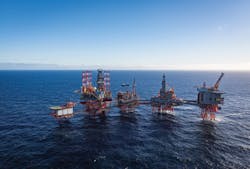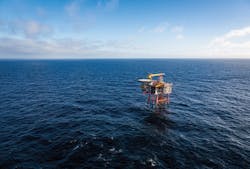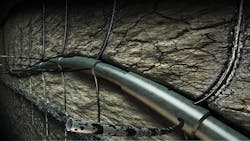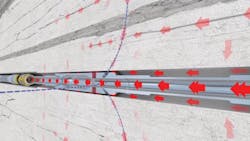Jeremy Beckman
Editor, Europe
Smarter wells, water injection helping to extend field life
Valhall is one of the longest producing fields in the North Sea, and operator Aker BP is looking to extend the lifespan out to 2060. A series of initiatives are under way to sustain production including drilling previously untapped reserves on different parts of the field and the wider Valhall area, some via new platforms; expanding water injection; and applying novel technical solutions to improve drilling efficiency and recovery. At the same time the company continues its long-term campaign to P&A redundant wells and remove the older platforms.
Amoco discovered Valhall in 1975 and produced first oil from the field seven years later initially through three bridge-linked steel platforms for drilling, production/compression and accommodation, with a wellhead platform added and connected in 1996. Production was exported through a subsea pipeline to the Ekofisk 2/4G riser platform. In 1990 Amoco also started oil and gas production from the Hod field, 13 km (8 mi) to the south of Valhall via Norway’s first unmanned platform, remotely controlled from the Valhall field center.
The Valhall field center. (Courtesy Aker BP)
In 2003 new operator BP Norge took steps to optimize performance of the wells through installing the IP water injection and drilling platform at the field center, supplemented by gas lift, also adding the identical Flank North and Flank South 16-slot wellhead platforms 6 km (3.7 mi) to the north and south to extend production to new areas. These facilities too are controlled from the field center. Earlier this decade BP overhauled the existing complex, partly because of seabed subsidence which is a common issue affecting chalk fields in this region. The company installed a new processing and hotel platform, PH, at the field center to take on the functions previously performed by the existing PCP and QP platforms, both of which were subsequently shut down.
Chalk imaging
The Valhall structure trends NW-SE and extends over an area of around 81 sq km (31 sq mi) in roughly 70 m (229 ft) water depth in the southern Norwegian North Sea. It is located on the Lindesnes Ridge, an elongated anticlinal feature, with productive reservoirs in chalk within the Upper Cretaceous Tor and underlying Hod formations. The chalk is highly porous mainly due to high formation overpressure which preserved the porosity during burial: The Tor formation chalk is fine-grained with good reservoir quality, and extensive fracturing that allows the paraffinic 36°API oil and water to flow more easily than within the Hod formation.
Flank North platform. (Courtesy Aker BP)
“Imaging the reservoirs can be challenging due to complexity in the overburden of the crest of the field, as well as interpreting 4D seismic effects in a sometimes thin reservoir,” said Per Mikal Hauge, VP Operations Valhall. “This is why we commissioned a life-of-field seismic program in 2003, initially accomplished by laying of 120 km (74 mi) of seabed cable – which has enabled 19 repeat 4D seismic surveys. 4D ocean bottom seismic has greatly improved the image and reduced uncertainties when planning new wells.
“Some of the solutions Aker BP has adapted are similar to those applied at other chalk fields in the southern Norwegian North Sea and the Danish sector. However, there are differences, mainly related to the fact that the Valhall chalk is more unstable. This explains, for example, why proppant fractured wells are used at Valhall and not at Ekofisk.”
Produced oil and NGLs from throughout the Valhall area continue to be sent through a subsea pipeline to Ekofisk (the 2/4G platform was recently decommissioned) for onward export across the North Sea to Teesside in northeast England. The gas heads through the Norpipe system to Emden on the German coast.
Aker BP, the present operator, estimates in-place resources throughout the Valhall area, including Hod, at 3-4 Bboe. To date 1 Bboe has been produced, with a recovery factor of 28% from Valhall and 17% from Hod. The company and new partner Pandion are now looking to extract a further 1 Bboe and to lift recovery from both fields to 43% through:
• New infrastructure and platforms
• Drilling more and ‘smarter’ wells
• Improved well completion and stimulation technologies such as Fishbones and Single-Trip Mulitfrac
• Improved reservoir monitoring and modelling, leading to better decisions
• Expand water injection
• Digital transformation.
Near-term opportunities identified include the Valhall Flank West development and Flank North water injection; redevelopment of Hod; producing from the Lower Hod formation; and drilling additional infill wells on Valhall Crest from the IP/WP platforms in the field center as well as infill drilling from the flanks platforms.
Out of the 150 or so development wells drilled in the Valhall area to date, 48 are currently active, comprising 42 oil producers and six water injectors at Flank North, Flank South, and the field center. There is an ongoing drilling campaign at Valhall Crest, with two more wells set to come onstream this year and two more in 2019.
Maintaining or improving the performance of the live wells is another priority.
“Aker BP has a well integrated onshore and offshore team,” said Hauge, “for optimizing production on the challenging high porosity and soft chalk that is prone to chalk production, with 24/7 onshore support available.
“Valhall is also highly linked into the company’s ambitious digitalization agenda,” Hauge points out, which includes the upcoming implementation of:
• Digital Oil Field software applications for production optimization
• Digital twins
• Data sharing
• Predictive and prescriptive maintenance supporting offshore operations using tablets and AR
• Digital logistics.
“Furthermore, Aker BP remains committed to its ambition of ‘planning a well in one day’ using integrated drilling tools on a common platform interfacing with our data,” he continued. “The Digital & Well alliances formed last year with Halliburton and Maersk Drilling are an important part of this and we are working closely with our alliance partners to achieve this goal.
Fluids flow through the Fishbone needles as well as through the needle annuli. Additional production comes from the main bore annulus through the production valve. (Courtesy Aker BP)
“On the stimulation side, new proppant fracture technologies have been implemented on Valhall that have the potential to reduce well construction cost and time significantly – and the new Fishbones technology is being specially developed for soft chalk, as a more optimal alternative to proppant fractures in certain areas of the field.”
Fishbones, designed to increase production rates and recovery in tight reservoirs, involves sending 12-m (39-ft) long needles from the wellbore into the reservoir formation, effectively increasing the wellbore drainage radius, connectivity with any natural fractures, and penetration through natural formation fluid flow barriers. Completion time and cost can also be significantly reduced with Fishbones making small oil pools economic. Recently Aker BP invested in and acquired a 17% stake in Fishbones AS, the company which developed the technology originally for a trial at Valhall from 2008-2012.
“The main benefit,” Hauge explained, “is a lower cost per barrel produced compared with established stimulation technology. Testing of the first commercial application will likely take place in the next well (G-11) drilled from the IP platform, a new producer targeting the East Flank of the field.
If successful, we expect to apply the technique more widely to improve production. In addition, Aker BP is considering proppant fracturing through coil to unlock further potential in existing wells. And we are developing and piloting other novel stimulation techniques such as Single-Trip Multifrac in new wells to reduce well costs and increase recovery.”
The company is also evaluating options to increase water injection at Valhall, presently around 25,000 b/d of water. “Up to now we have employed a fairly classical injection technique with horizontal wells and line-drive,” Hauge said. “All the recent injectors have been completed with sliding sleeves to be able to selectively shut of injection zones if required.”
Fishbone needles extend from the main wellbore, connect through vertical permeability barriers and access natural fractures. (Courtesy Aker BP)
Western extension
Earlier this year the Norwegian Ministry of Petroleum and Energy approved the plan for development and operation for Valhall Flank West, a NOK5.5-billion ($674-million) investment, designed to recover around 60 MMboe from the Tor formation on Valhall’s western flank, the least developed part of the field. This will involve drainage via natural depletion with the option to add water injection when the need arises. First oil is slated for late 2019.
The Wellhead Platform Alliance of Aker BP, Kvaerner, ABB, and Aker Solutions is executing the project which calls for a new 12-slot, normally unmanned installation (NUI) with a helideck, capable of accommodating up to 15 personnel. Initially producer wells will be drilled from six of the slots: Some of these could later be converted to water injectors, while the remaining slots will be retained for future developments. Production will be exported via a new pipeline to the field center for processing and subsequent export.
The NUI will be configured for minimal maintenance and fitted with sensors to facilitate real-time monitoring and condition-based maintenance. In addition, it will be fully electrified and controlled from the field center, with an 11-kV power supply provided through a new subsea umbilical from the PH platform. This will be sufficient to satisfy requirements at the NUI during both manned (550 kW) and normal unmanned (150 kW) operations.
Aker Solutions was assigned engineering and procurement activities for the topsides and jacket, with Kvaerner performing fabrication of the 5,000-metric ton (5,511-ton) platform at the Verdal yard, followed by hookup and commissioning. Apply Leirvik will supply the helideck and accommodation, while ABB and Siemens are responsible for the platform’s electrical, instrumentation, control and telecommunications system. Heerema Marine Contractors will install the platform in 2019, with Subsea 7 installing the riser system and umbilical connecting Flank West to the field center via a 4-km (2.5-mi) tieback.
Maersk Invincible.
(Courtesy Maersk Drilling)
Next year Aker BP’s Drilling & Wells (D&W) jackup alliance with Maersk Drilling and Halliburton will start constructing the development wells using the newbuild harsh environment jackup Maersk Invincible. As with the Wellhead Platform Alliance, the aim of the D&W is to align all parties around common goals that encourage pursuit of continuous improvement, creating greater value for all concerned. Maersk provides some of its higher-performance jackups to implement digital solutions to improve drilling efficiency and reduce the well costs. Halliburton applies its Digital Well Program which is designed to streamline project execution and optimize drilling decisions.
“Our next step will be to look into a new alliance for interventions to complement our existing D&W alliances,” Hauge said. “Well interventions are essential to ensure stable production and optimized management of our base. Aker BP is therefore looking at how to improve this area of business together with the company’s suppliers.”
During 1Q 2018 the Valhall partners also sanctioned the $100-million Valhall Flank North Water Injection project to expand water injection to the northern drainage area. This will help sustain Valhall’s production through enabling water injection to existing depleted areas, with the potential to increase recovery from the reservoir by 7 MMboe. Development drilling should get under way during 4Q, with water injection initiated next spring when the pipelines to the field center, and the newly added risers, will be in place.
All the current development programs necessitate brownfield modifications to the existing platforms. In addition, the company is considering a full-scale redevelopment of Hod, where the original platform has been shut down. All present production from Hod comes from wells drilled into the reservoir from the Valhall field center. The plan is to install a new 12-slot unmanned installation (UI) at Hod to recover the field’s remaining 64 MMboe, and to use the results of a recent seismic survey to prove further reserves in the area through exploration and appraisal drilling, which may include HP/HT wells – and possibly additional wells lots on the UI. The first appraisal well will be next year, followed by concept selection.
P&A, platform removal
As has been the case at Ekofisk and, Tyra, chalk compaction caused by pressure depletion and water weakening has led to seabed subsidence in the Valhall field center, although ongoing monitoring indicates that the rate of subsidence has slowed to around 7 cm/yr at present. P&A activities continue on the old DP drilling platform, while the topsides of the cold-stacked, original QP quarters platform will be removed in 2019. By 2026, the original DP and PCP topsides and all three jackets will also have been removed. The Valhall field center will then comprise the ‘new’ PH and IP/WP platforms, all of which have a sufficient air gap to overcome any further subsidence that may arise over the next few decades.
Under long-term framework agreements Allseas will perform various transport and installation (T&I) and removal services using the Pioneering Spirit, starting with the QP topsides and QP/DP bridge in 2019, followed by disposal of the structures. Allseas has options to also remove the QP and 2/4G jackets. Heerema has a T&I agreement covering the Flank West installation and subsequent field center removals.
In 2014 the jackup Maersk Reacher started P&A of the first of 31 wells at the field center, with Maersk Invincible taking over in mid-2017 for the remaining 18 wells from the old DP platform.
For the P&A campaign Maersk Invincible has been supplied with electricity sent through a 500-m (1,640-ft) HV cable from the IP platform. The field center in turn receives its power directly from Lista on the shore via a 294-km (182-mi) subsea cable. The arrangement is probably unprecedented for an offshore drilling rig anywhere, Hauge claimed. Aker BP has calculated that this arrangement will reduce emissions associated with the rig’s various tasks by 15,000 metric tons/yr (16,535 tons/yr) of carbon dioxide and 168 metric tons/yr (185 tons/yr) of nitrogen oxide (NOx). The company gained financial assistance for this project from the Norwegian business sector’s NOx Fund. •








